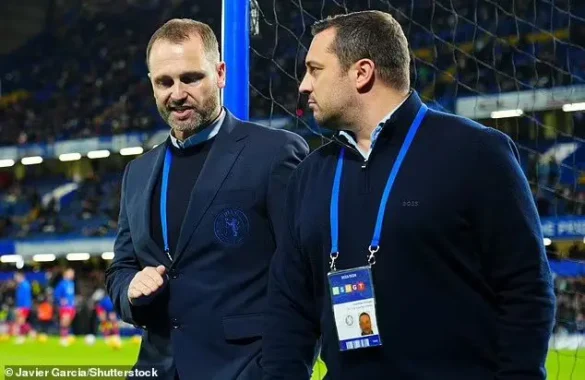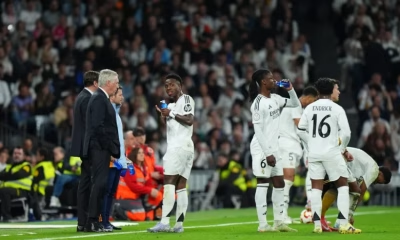Chelsea
BREAKING NEWS: Paul Winstanley and Laurence Stewart have revealed the real reasons behind Chelsea’s strategy of offering long-term contracts

Since Todd Boehly and Clearlake Capital assumed ownership of Chelsea in 2022, the club has regularly offered new players lengthy contracts, often spanning six or seven years, extending well into the 2030s.
Recently, Cole Palmer and Nicolas Jackson renewed their commitments to Chelsea, signing contracts that will keep them at the club until 2033, resulting in an exceptional nine years remaining on their agreements. This approach has drawn criticism from figures like former player Emmanuel Petit, who suggests that such long-term deals might diminish a player’s drive, as they may feel less compelled to prove themselves after securing a lengthy contract.
Despite this criticism, Chelsea’s management defends their strategy. One of the initial justifications for extending contracts was financial; by distributing the transfer cost over the contract duration, the club could better manage its expenses. However, recent regulations now limit the amortization of transfer fees to a maximum of five years, raising questions about whether Chelsea’s primary motive for these long-term deals was to navigate Profit and Sustainability Regulations (PSR).
Nevertheless, Chelsea’s technical director Paul Winstanley and co-sporting director Laurence Stewart assert that financial considerations were not the main motivation. In an interview with *The Telegraph*, Winstanley explained that while many clubs stick to traditional methods, Chelsea aims to be innovative by adopting new strategies. He expressed confidence in their approach, stating that they saw significant potential in it, prompting their decision to maintain this practice.
Winstanley noted that the closure of financial loopholes, combined with Chelsea’s ongoing use of long contracts, indicates that PSR was not the primary concern. If financial strategy were the sole aim, the club would have ceased offering long deals once regulations changed.
The club’s leadership, he emphasized, had other long-term objectives in mind regarding how these contracts would function. Other clubs, such as Aston Villa, have begun to follow suit, exemplified by their decision to offer Jhon Duran a contract until 2030.
Stewart remarked that these extended deals reflect the club’s faith in players’ abilities and their future contributions. He underscored the importance of identifying talent when committing to such lengthy contracts and highlighted the club’s focus on player development.
According to Stewart and Winstanley, the true value of these long contracts lies in securing talent while fostering growth and improvement over time. Chelsea’s strategy of offering long-term contracts—some extending up to nine years—has sparked significant discussion in the football community. Although initially perceived as a financial tactic to spread transfer costs and align with PSR, this reasoning has been questioned due to regulatory changes restricting the amortization of transfer fees to five years.
Despite this shift, Chelsea’s leadership insists that their motivations are rooted in a commitment to long-term player development and retention. This vision is shaping how top football clubs approach player contracts and development, with other clubs starting to adopt similar strategies.
-

 Manchester United7 months ago
Manchester United7 months agoManchester United fired off more than 22 attempts trying to find the net against Nottingham Forest, with one player squandering around six clear opportunities without scoring. Ruben Amorim was visibly frustrated, publicly calling out a Manchester United star for failing to convert even once, despite facing an unguarded goal on multiple occasions.
-

 Manchester United7 months ago
Manchester United7 months agoBREAKING NEWS: “Isak Has Agreed to Join Man United… BUT Only If They Allow That Guy to Join Us!” – Eddie Howe’s Shocking Transfer Demand Stuns Fans.
-

 Liverpool7 months ago
Liverpool7 months agoLFC TRANSFER UPDATES LIVE Liverpool open to selling ( 7) players this summer, including £50 million star who Arne Slot claimed is ‘important’
-

 Liverpool7 months ago
Liverpool7 months agoReal Madrid are discussing a move to appoint former Liverpool boss Jürgen Klopp as their new manager if Carlo Ancelotti steps away and takes over Brazil.
-

 Real Madrid7 months ago
Real Madrid7 months agoI have warned Carlo Ancelotti about that particular player, he refused to bench him, He keeps causing problems to the teams, He Almost Denied Real Madrid three points against Real Sociedad after taking the lead in the Copa del Rey Semi Finals “: Former Real Madrid Legend Cristiano Ronaldo names ONE player who doesn’t deserve to start for Real Madrid, warned Ancelotti about the unforgivable mistake
-

 Premier League7 months ago
Premier League7 months agoPremier League Shock: Manager Sacked Amid Season Struggles”
-

 Liverpool7 months ago
Liverpool7 months agoAlexander Isak to Liverpool swap deal option emerges as transfer pathway clears
-

 Barcelona6 months ago
Barcelona6 months agoFIFA officially announces Barcelona will play in the FINAL—and Inter Milan have been KICKED OUT… after referee Szymon Marciniak was ARRESTED in a stunning late-night operation!…
